
What Is the Amazon Affiliate Program and How to Become an Amazon Associate
In this guide, we’ll walk you through how the Amazon’s affiliate program can benefit you and your audience, and teach you how you can become an Amazon Associate. Amazon is the most popular online shopping site in the English-speaking world. Chances are good that, even if you’re not a regular Amazon customer, you’ve bought something from this site in the past! (Or even 10 minutes ago.)
In addition to being a huge buyer’s destination, lots of people have also made money selling things on Amazon—but that’s not the only way to generate passive income from this popular shopping site.
Today, we’re going to talk about the other way of making money on Amazon—by promoting products others are selling, through the Amazon affiliate program, known as Amazon Associates.
We’ll go into detail on what it takes to qualify for Amazon’s affiliate program, how to get started with an Amazon Associates account, and how to get your first affiliate link! Then we’ll cover the benefits and upside of using this platform as a source of some of your affiliate income, along with the downsides and challenges of using Amazon’s affiliate program.
Finally, we’ll go over some powerful tips to help you maximize your success earning an affiliate income from promoting Amazon products, and answer common questions about the Amazon Associates program.
Contents
- What is The Amazon Associates Affiliate Program and why should I join?
- Amazon Affiliate Program Eligibility Guidelines
- How to become an Amazon Affiliate: 6 quick steps to create your Amazon Associate account
- How to get Amazon affiliate links to promote
- 8 tips for generating Amazon affiliate income
- 6 bonus tips for boosting your Amazon affiliate income

Get Unstuck in just 5 minutes, for free
Our weekly Unstuck newsletter helps online entrepreneurs break through mental blocks, blind spots, and skill gaps. It’s the best 5-minute read you’ll find in your inbox.
Free newsletter. Unsubscribe anytime.

Join 100k+
Subscribers

What is the Amazon Associates affiliate program and why should I join?
There are plenty of reasons to choose Amazon Associates as an affiliate marketing option—and we’ll get to those in a moment. But I want to start by talking about maybe the biggest downside of using Amazon affiliate links: the commissions.
How much does Amazon’s affiliate program pay?
Amazon’s affiliate commission rates—the percentage of the sale price you receive when someone purchases a product you recommend—are, well, not so great. Here’s a chart showing the commissions for different product categories (as of June 2024):
| Amazon Product Category | Affiliate Commission |
| Amazon Games | 20.00% |
| Luxury Beauty, Luxury Stores Beauty, Amazon Explore | 10.00% |
| Digital Music, Physical Music, Handmade, Digital Videos | 5.00% |
| Physical Books, Kitchen, Automotive | 4.50% |
| Amazon Fire Tablet Devices, Amazon Kindle Devices, Amazon Fashion Women’s, Men’s & Kids Private Label, Luxury Stores Fashion, Apparel, Amazon Cloud Cam Devices, Fire TV Edition Smart TVs, Amazon Fire TV Devices, Amazon Echo Devices, Ring Devices, Watches, Jewelry, Luggage, Shoes, and Handbags & Accessories | 4.00% |
| Toys, Furniture, Home, Home Improvement, Lawn & Garden, Pets Products, Headphones, Beauty, Musical Instruments, Business & Industrial Supplies, Outdoors, Tools, Sports, Baby Products, Amazon Coins | 3.00% |
| PC, PC Components, DVD & Blu-Ray | 2.50% |
| Televisions, Digital Video Games | 2.00% |
| Amazon Fresh, Physical Video Games & Video Game Consoles, Grocery, Health & Personal Care | 1.00% |
| Gift Cards; Wireless Service Plans; Alcoholic Beverages; Digital Kindle Products purchased as a subscription; Food prepared and delivered from a restaurant; Amazon Appstore, Prime Now, or Amazon Pay Places | 0.00% |
| All Other Categories | 4.00% |
Amazon also offers commission income on “Bounty Events,” like when customers register for an Amazon Prime Free Trial or add an item to a baby registry after clicking your affiliate link. You can learn more about this and other details of Amazon’s affiliate commission rates by visiting their fancily named Associates Program Standard Commission Income Statement.
So these are Amazon’s rates. And to be honest, you can do better with other affiliate networks that offer higher commissions. Some, like ClickBank, offer rates as high as 75 percent for certain products. In comparison, Amazon’s rates seem downright stingy.
So why bother with the Amazon affiliate program when there are seemingly much higher commission rates waiting elsewhere? Thankfully, there are two great reasons to do just that.
Amazon Affiliate Program Advantage #1: It’s where lots of people shop
First, Amazon has something that tops all the others. You could call it brand equity, or trust, or name recognition. People know Amazon, and they trust it as a source to buy stuff. According to Jungle Scout, in 2023, more people started their product searches on Amazon than anywhere else—56 percent compared to 42 percent for search engines like Google.
But more than just that, 75 percent of shoppers shop on Amazon most of the time. And Amazon has awesome conversion rates—the rate at which a customer who visits the site actually purchases something. If you’re talking about Prime customers, as many as 74 percent of them convert. That’s compared to an average of less than 10 percent for most retail sites!
So what Amazon Associates may lack in affiliate commission rates, it makes up in awareness, conversion rates, and shopper loyalty.
Amazon Affiliate Program Advantage #2: You get the whole cart
That brings us to the next, and perhaps the biggest benefit of using Amazon affiliate links. That is, even if you have a link for a specific product, you can still make money on any product a person purchases after they click on your link.
That’s right! Let’s say your affiliate link promotes a book. Someone clicks on it, lands on Amazon, continues to shop, and decides to also buy a mattress. Guess what! You’ll get a commission for the book and the mattress purchase.
And here’s perhaps the best part: you’ll get the mattress commission even if the person doesn’t buy the book! You see, when someone clicks on your link, Amazon adds a cookie to their browser that tracks anything they put in their shopping cart over the next 24 hours and gives you a commission if they purchase it.
As you can imagine, this can add up nicely for you.
So what’s the bottom line for you as an affiliate marketer? Is Amazon Associates worth it as an affiliate revenue source?
My opinion is that you should definitely consider Amazon Associates as you’re building your “portfolio” of affiliate marketing options. Despite the low commission rates compared to some other affiliate networks, there are a couple powerful benefits that “stack up” to help make Amazon Associates a pretty strong affiliate network program.Affiliate marketing on Amazon may not make you rich (at least right away), but it’s a really solid, reliable place to start. And even though the Amazon affiliate commission rates may not be as high as some networks, your likelihood of a sale is greater on Amazon. Plus, you can get a share of a customer’s entire cart if they click on your affiliate link—even if they end up buying something different from the original product you promoted. And the fact that it’s the most popular online marketplace in the Western hemisphere is nothing to sneeze at!
Now that you know why to consider Amazon Associates as an affiliate marketing option, let’s talk about the eligibility requirements for becoming an Amazon Associate.
Amazon Affiliate Program Eligibility Guidelines and Rules
The Amazon Associates program is open to just about anyone, but there are a few requirements you must meet if you want to start making money using Amazon affiliate links.
First, you must be 18 or older (or a parent will need to sign you up if you’re younger) and have a valid tax ID number or Social Security number, as well as a valid mailing address and bank account in the country where you plan to promote Amazon products.
You also need to have an active website, blog, social media account (a YouTube channel, or a TikTok account, for example), or Alexa Skill for which you’re creating relevant content.
After you apply, someone from Amazon will review your site and your content to make sure it’s what they’re looking for.
It doesn’t end there — Amazon’s Affiliate Program has lots of rules and policies
You’ll also need to comply with the Amazon Associates program’s policies and guidelines—and there are plenty of them!
A little later in this article (in “Must do #7: Read the Amazon Associates fine print”), we’ll cover a few of the key guidelines you’ll need to follow to keep your Amazon Associates account in good standing.
However, I highly suggest you acquaint yourself with all of Amazon’s affiliate program’s operating policies before you apply. Even though our team keeps close tabs on these guidelines, Amazon can change them whenever they like, so it’s always crucial to go right to the source!
So grab a coffee, turn on do not disturb, and head to Amazon’s Associates Program Policies page.
Now that you know what it takes to become an Amazon Associate, let’s go through how to sign up for an account!
How to become an Amazon Affiliate: 6 quick steps to create your Amazon Associate account
Let’s say you’ve decided to go for it and sign up as an Amazon Associate.
We’ll now walk through exactly how to do that, so you can get started on your path to successful affiliate marketing on Amazon!
1. First, go to https://affiliate-program.amazon.com/ and click Sign Up.
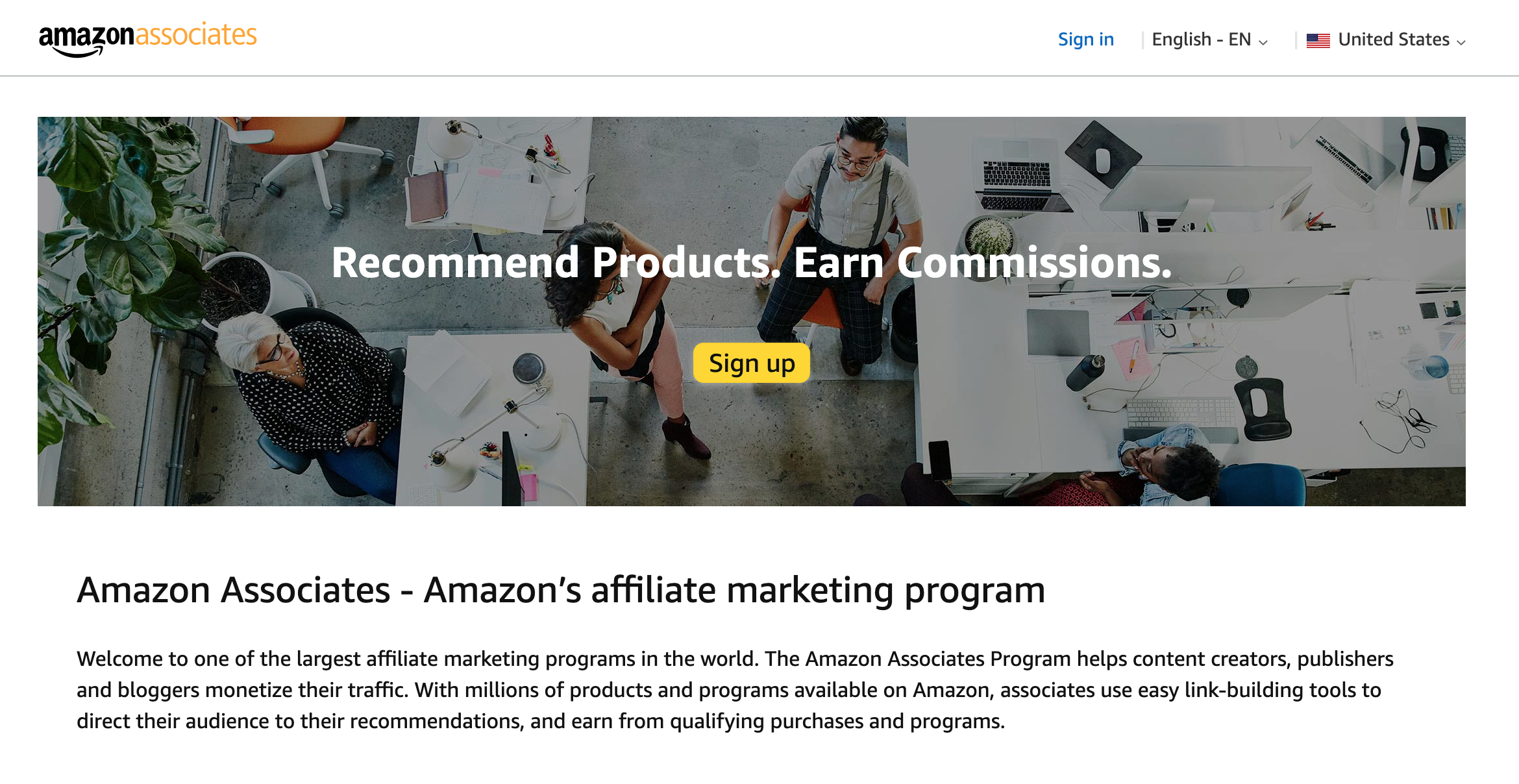
2. Then, you’ll see a page that gives you the option to either sign in or create a new Amazon account.
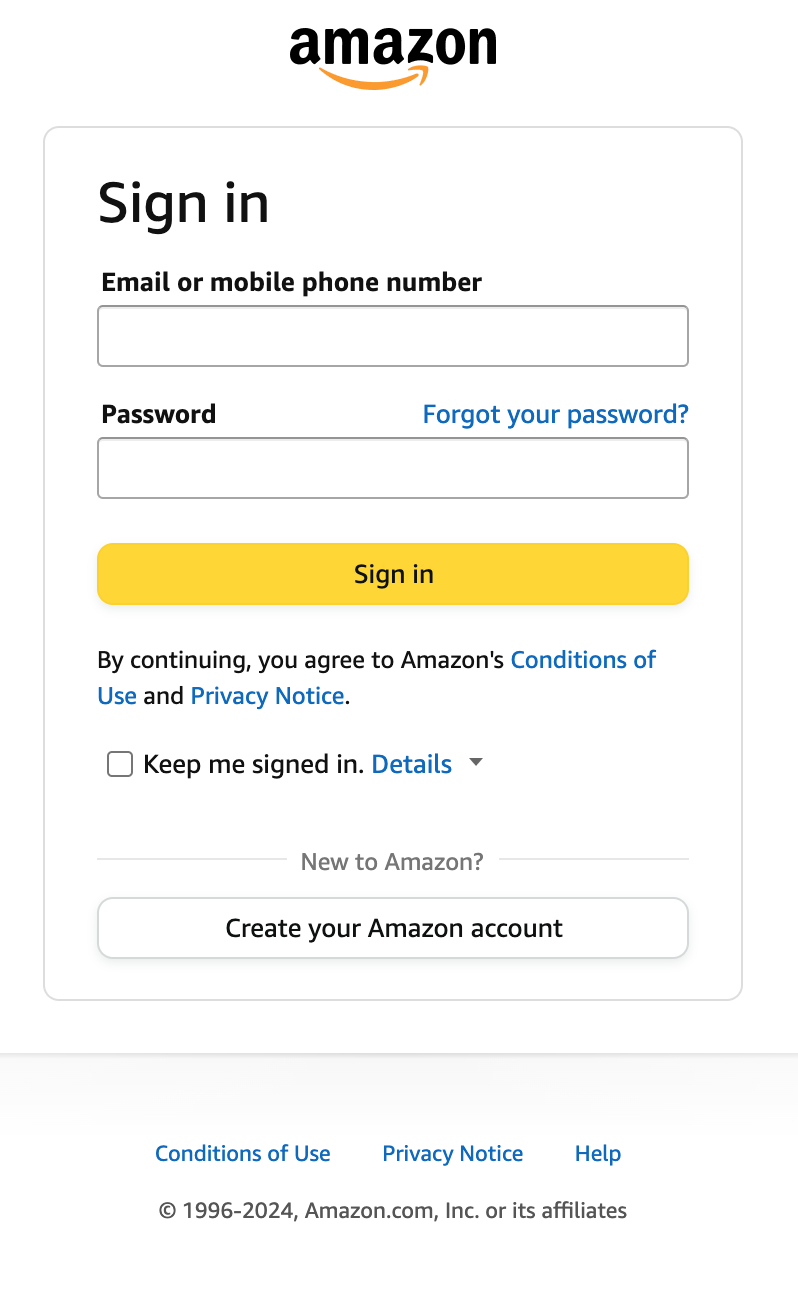
3. Next, you’ll start creating your account by providing your physical address where payments should be sent. If the main contact for your Amazon Associates account is someone other than the person you list on the address, you’ll need to select “Someone else” and enter their details at the bottom of the form
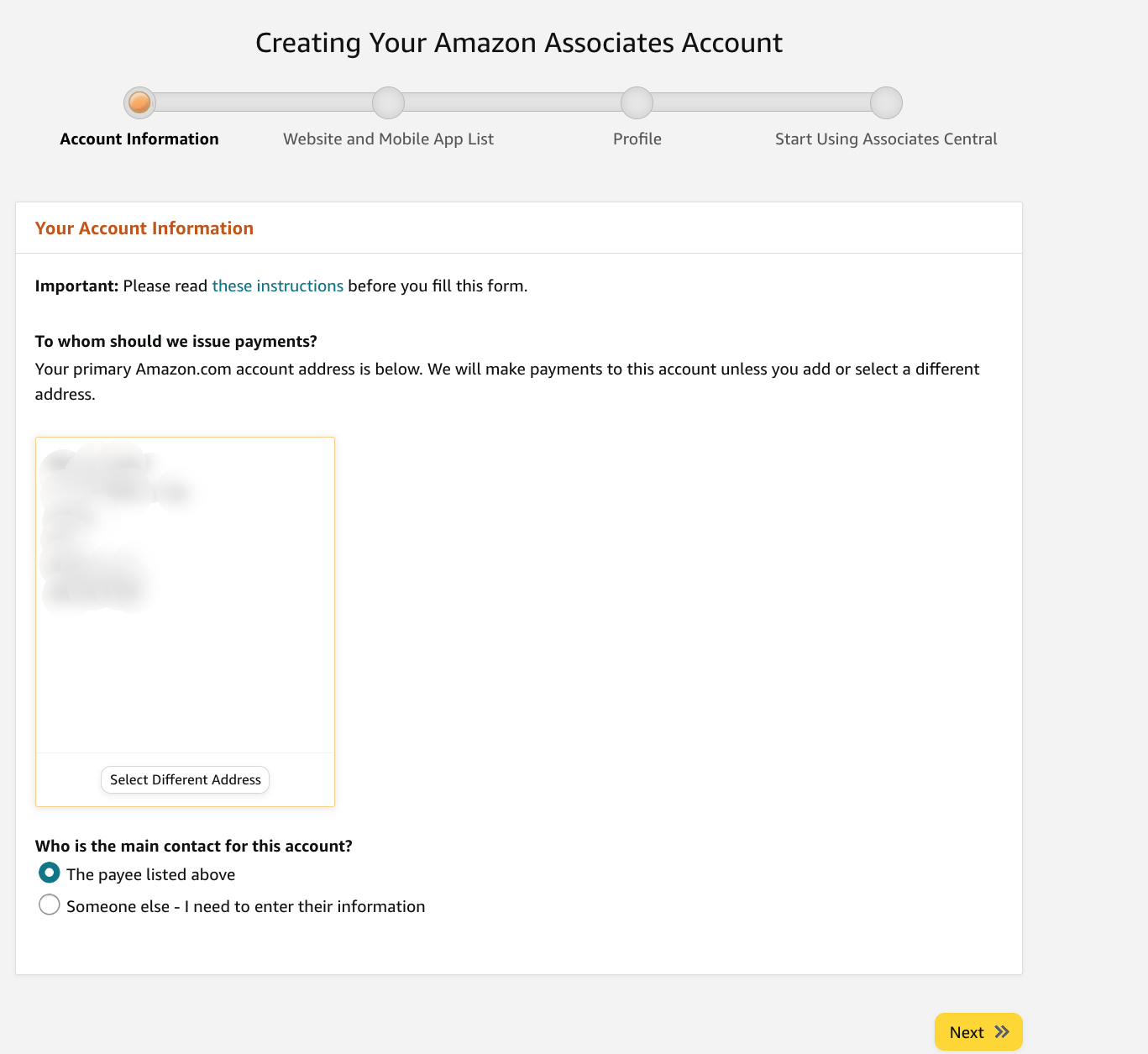
4. Next, you’ll enter the URLs of your website(s) and mobile apps (if applicable) you’ll be using to promote your Amazon affiliate links. You need to enter at least one URL! Click Next and you’ll be prompted to confirm if any of the sites or apps you entered aimed at children under 13.
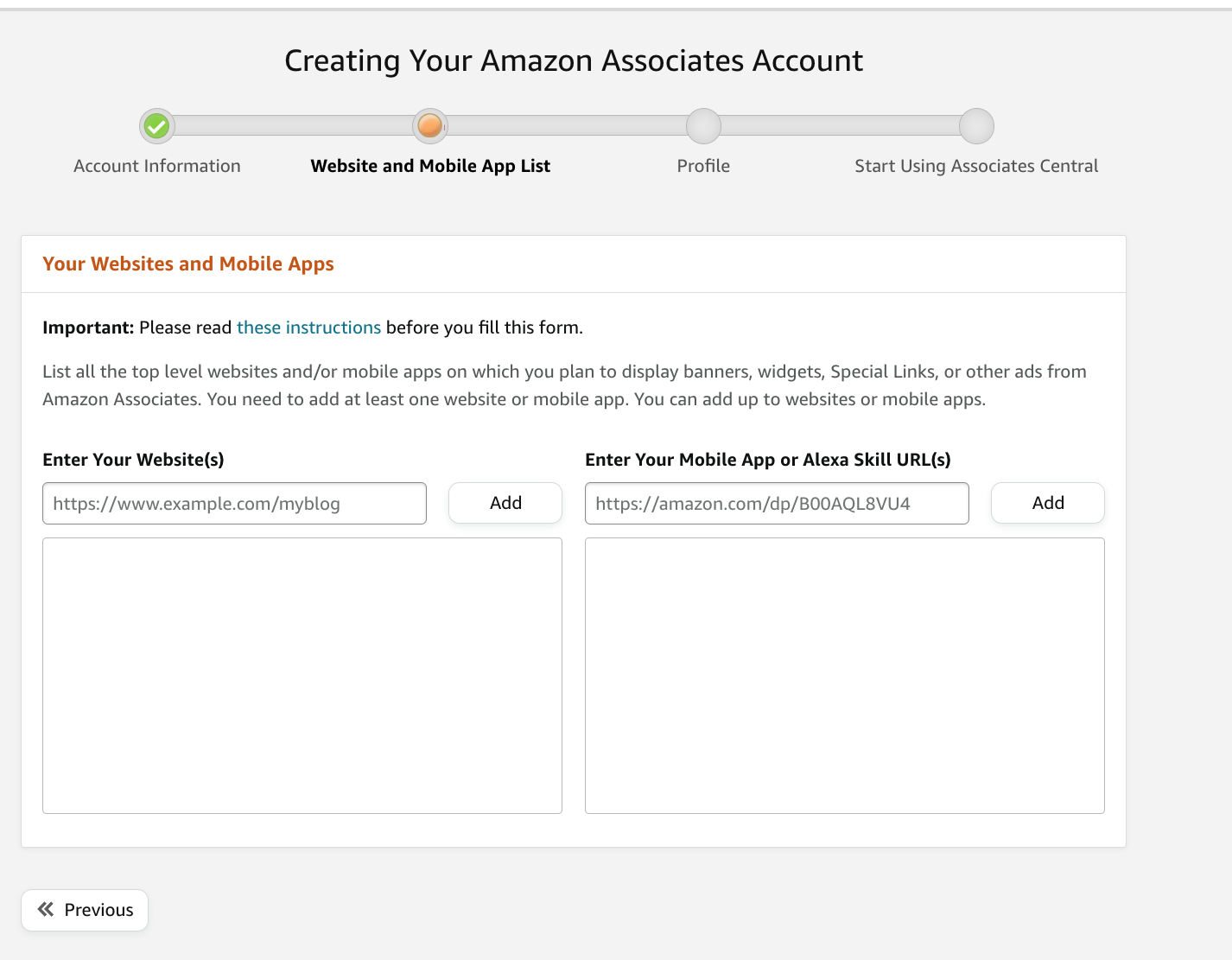
5. On the next screen, you can choose an Associates Store ID. This is basically a username that identifies your affiliate account. If your preferred name isn’t available, Amazon will suggest a similar one later on. You’ll also need to describe the kind of content you create and where you heard about Amazon Affiliates.
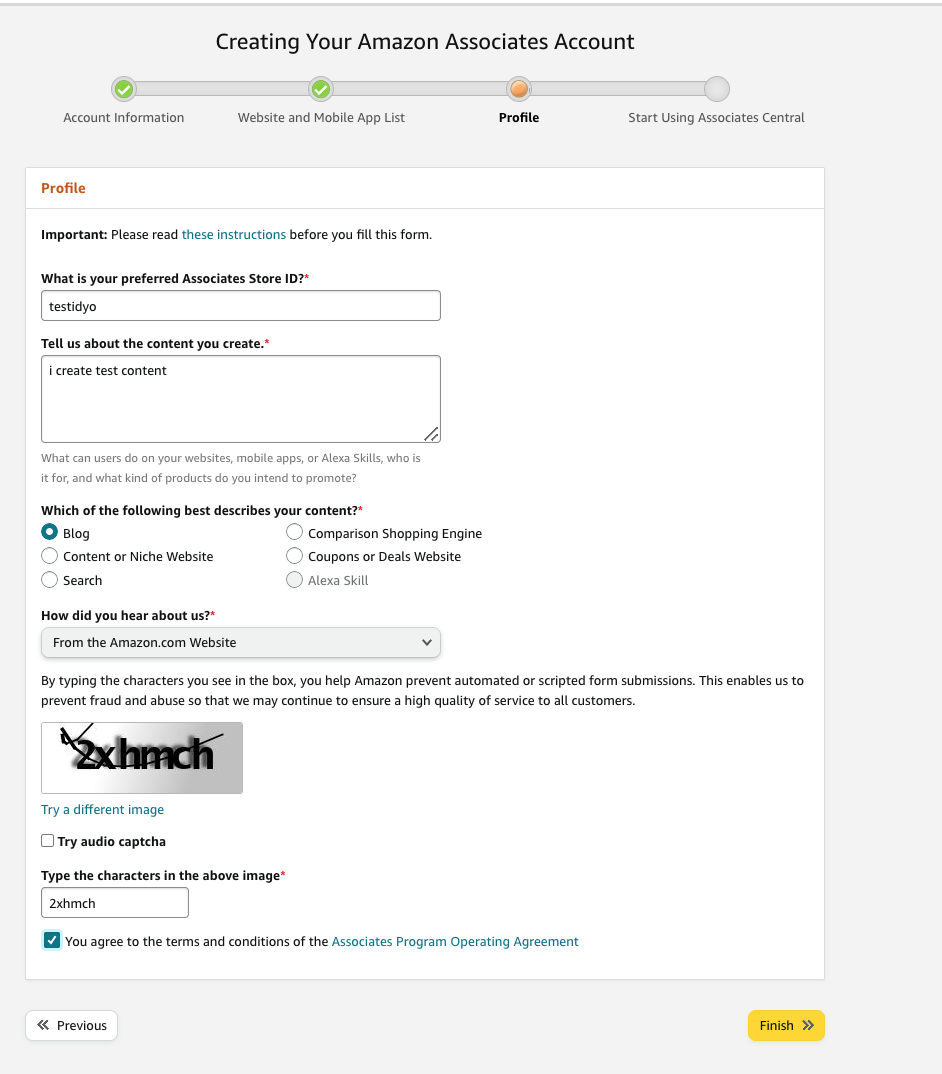
6. Click Finish, and you’ll see a page with your new Amazon Associates Store ID! You’ll have the option of entering your payment and tax information now or later.
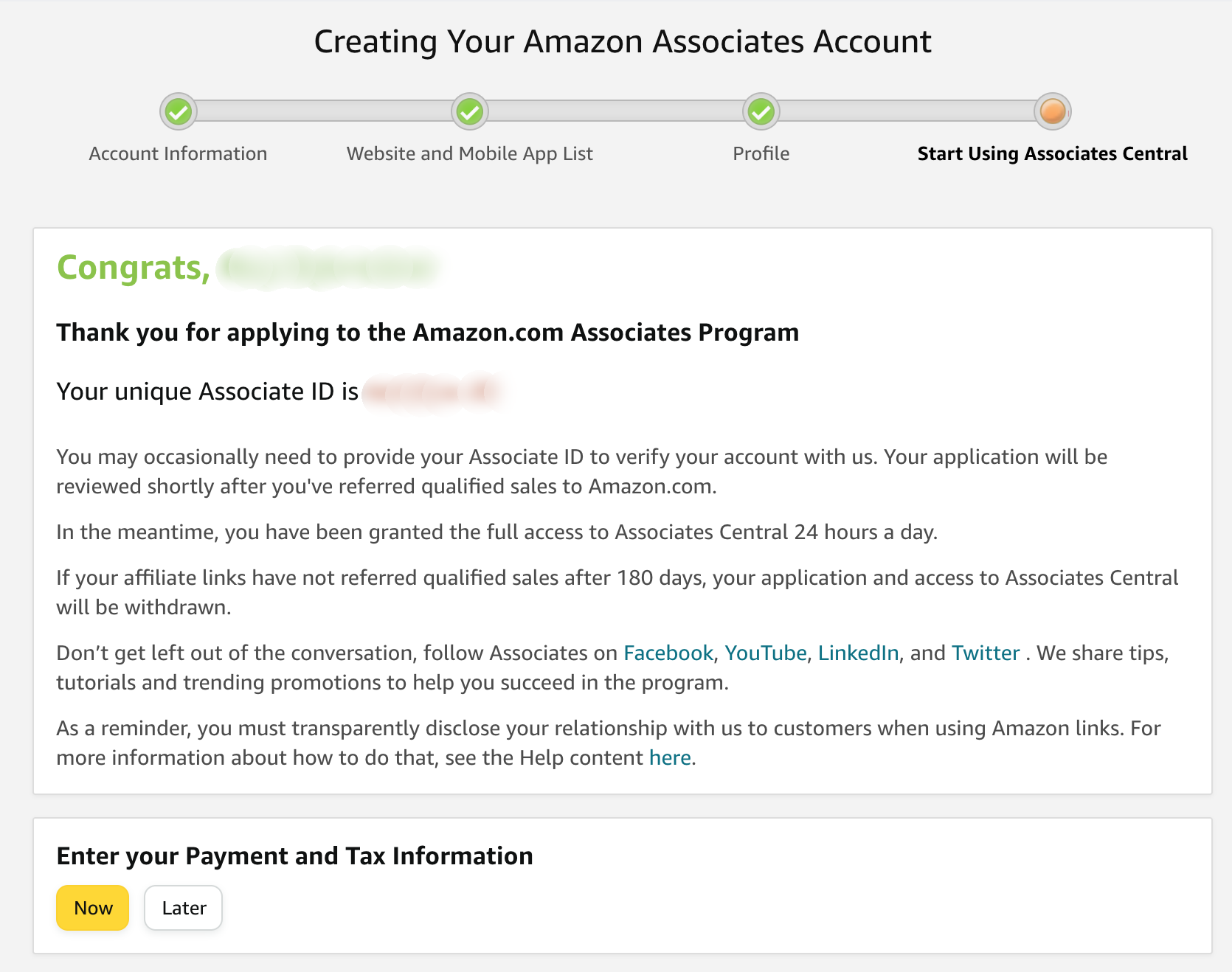
7. If you choose Later, you’ll see a prompt when you log in at https://affiliate-program.amazon.com/home to add those details. Remember, you’ll need to complete this step before you can get paid!
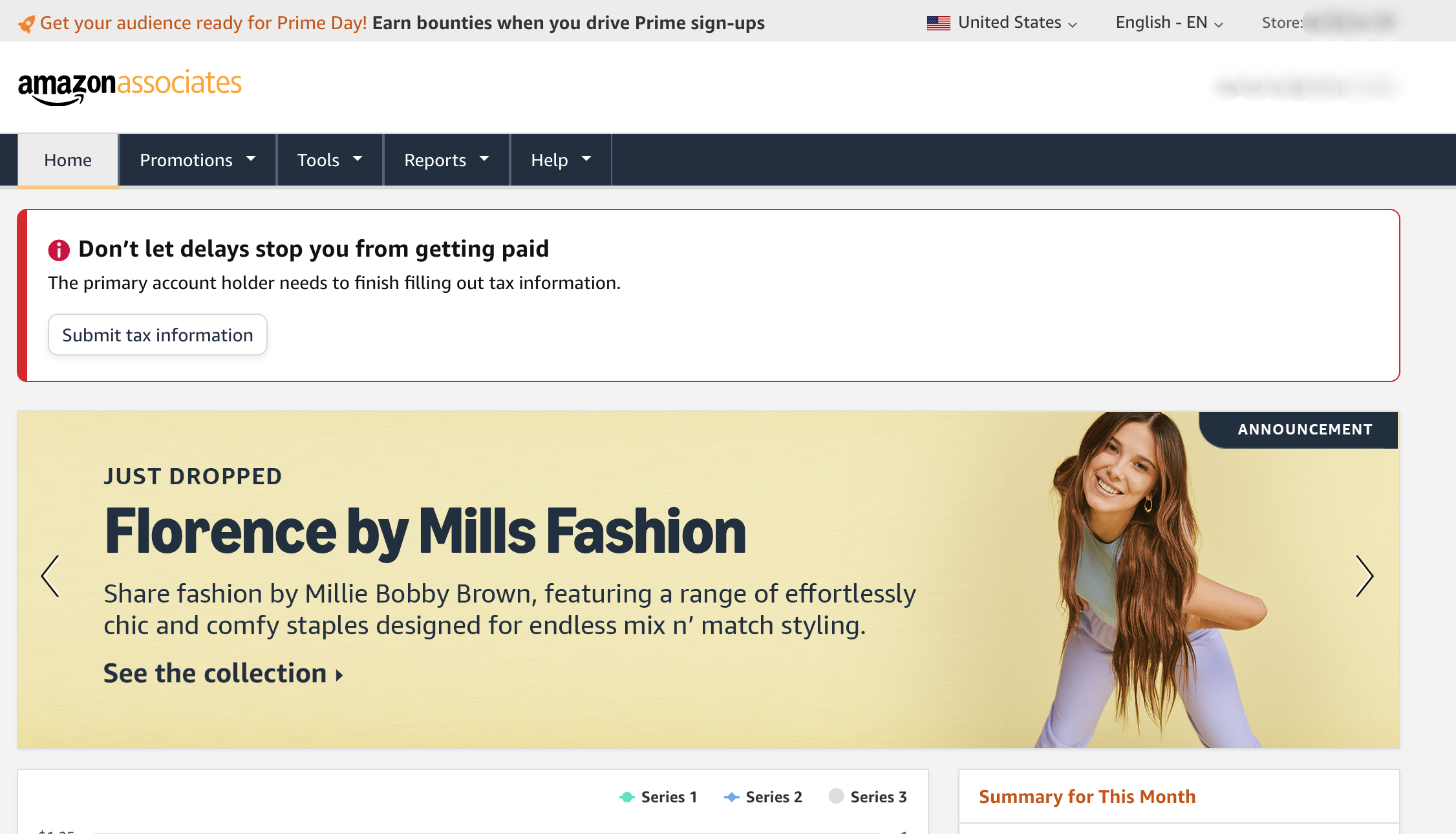
Now let’s talk about how to get started promoting products using your brand-new Amazon affiliate links.
How to get Amazon Affiliate links to promote
Now that you’ve set up your account, the next step is getting your first affiliate link. Thankfully, this part is also pretty easy!
Previously, you had to go to Amazon’s Associates Central site to create an affiliate link for a specific product.
Now, however, you can use either the SiteStripe tool, a browser toolbar for desktop computers, or Mobile GetLink, a feature in the Amazon mobile shopping app.
How to create your first affiliate link using SiteStripe
The SiteStripe is a toolbar that appears at the top of every Amazon page you visit, as long as you’re logged in using your Associate account.
To install SiteStripe:1. Log in to your Amazon Affiliates account, then click on Tools -> SiteStripe.
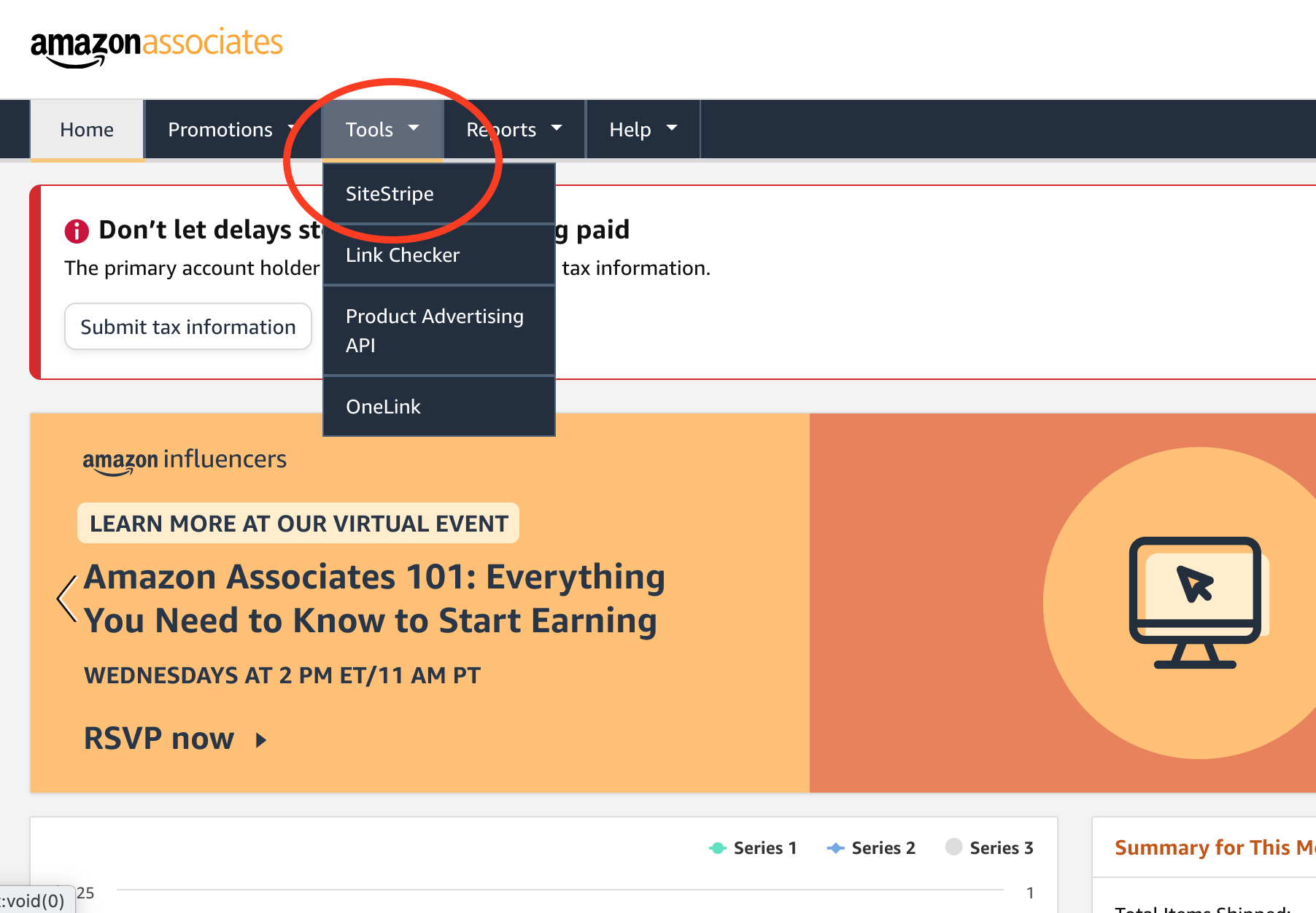
2. On the next screen, click on Learn More.
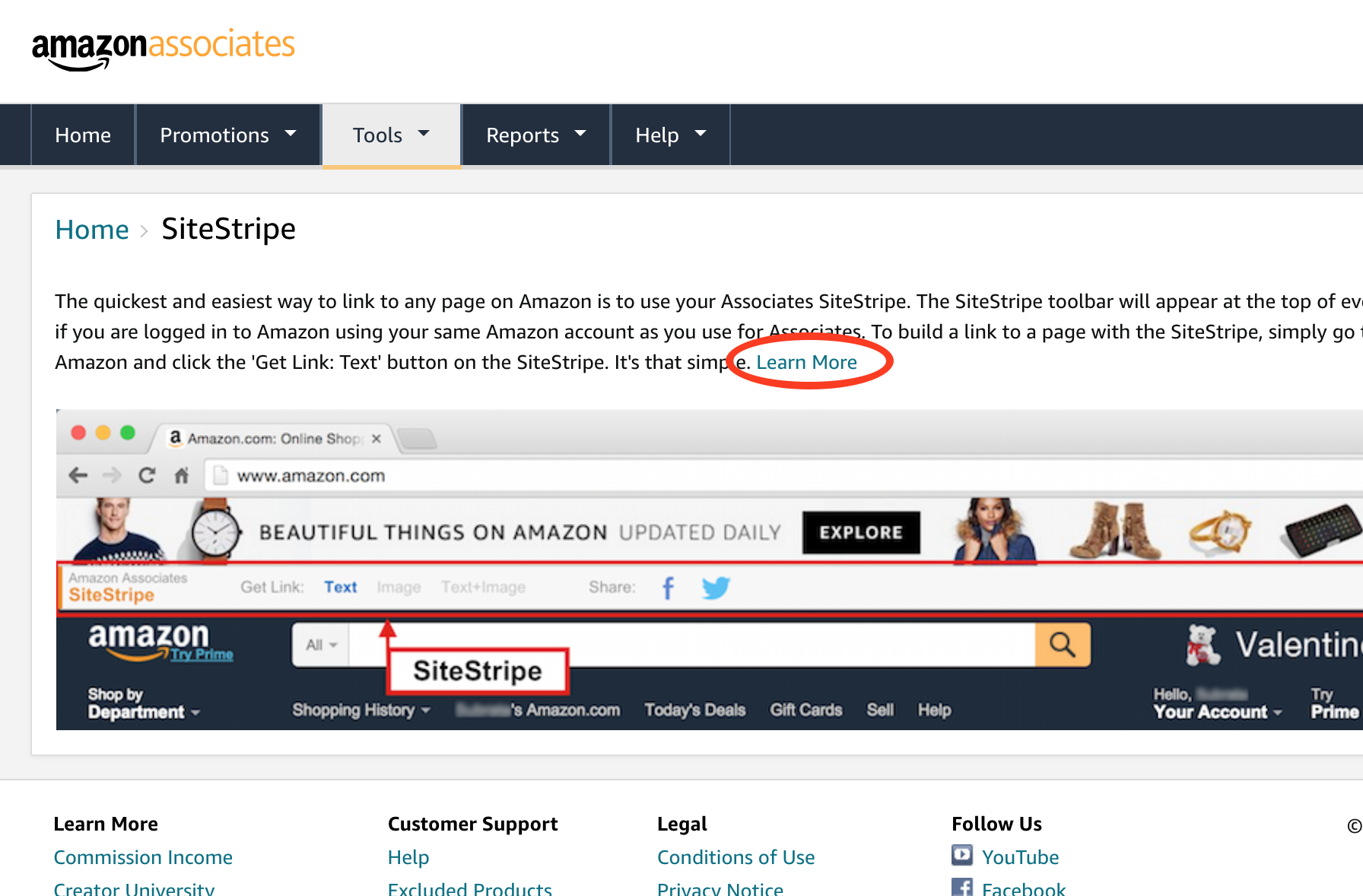
Make sure Display Status is set to Enabled.
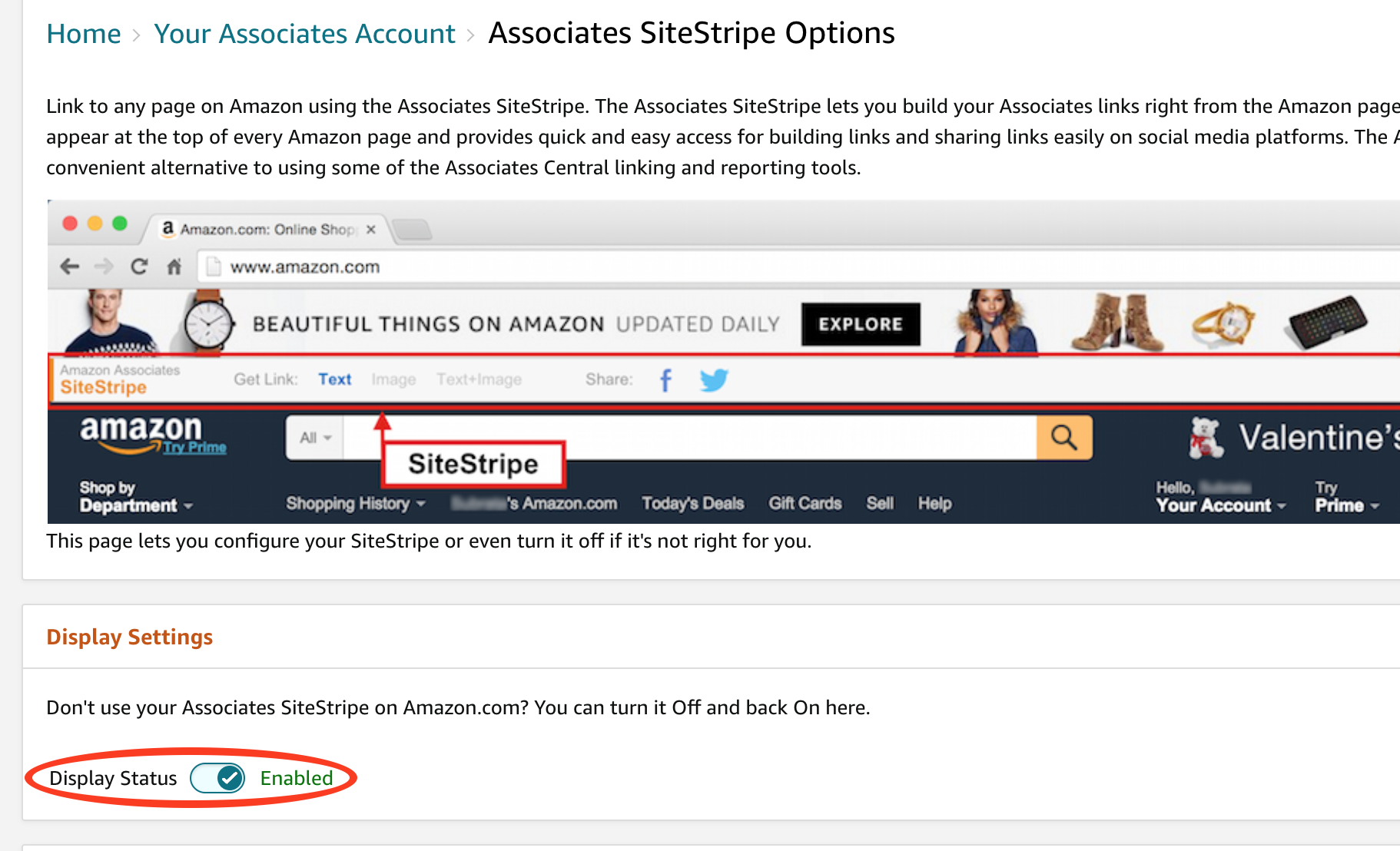
Go to the Amazon home page and check that SiteStripe is active—you should see the toolbar at the top of the page.
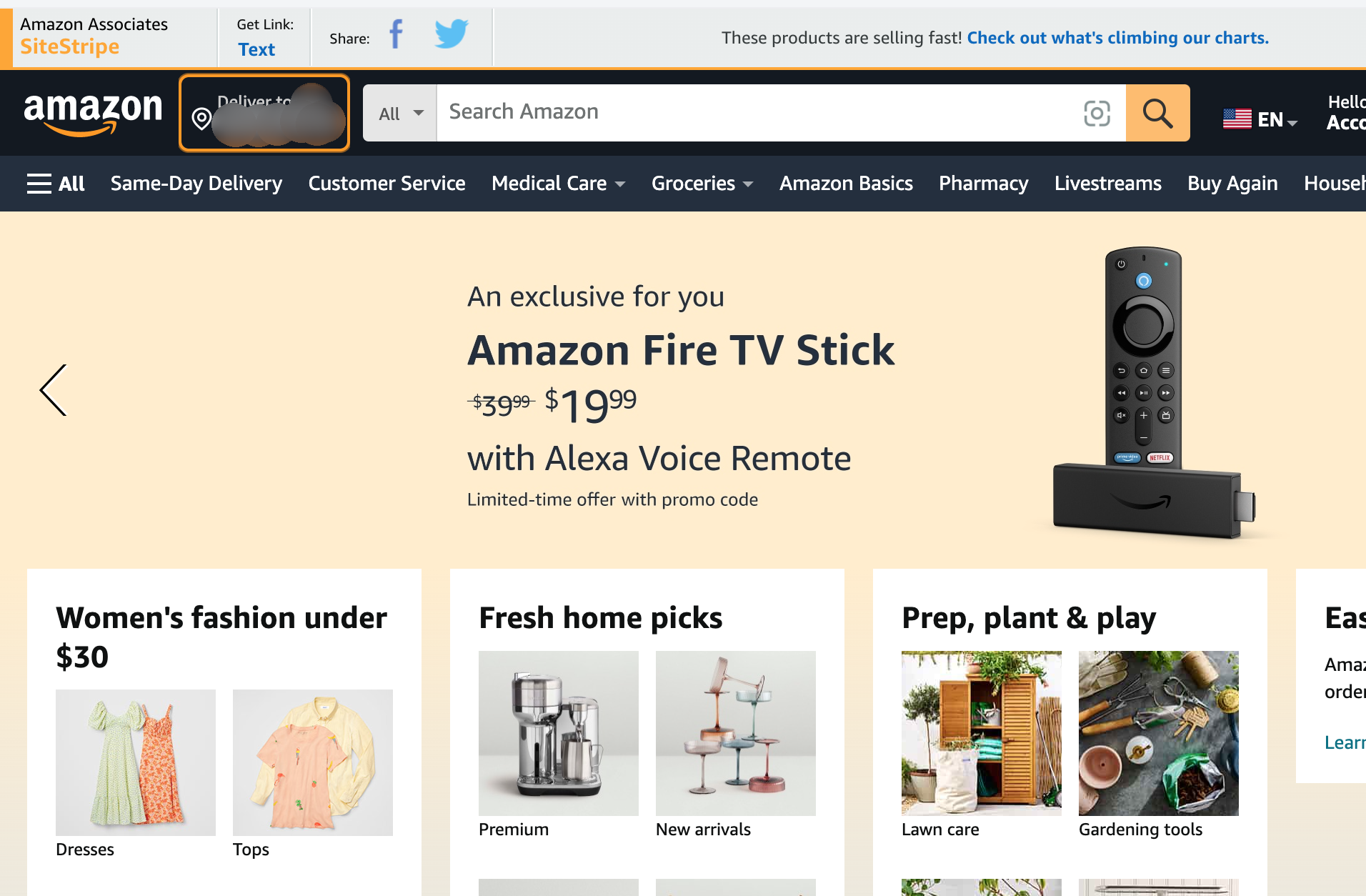
Go to the product page for which you’d like to create an affiliate link, and click Text in the SiteStripe toolbar.
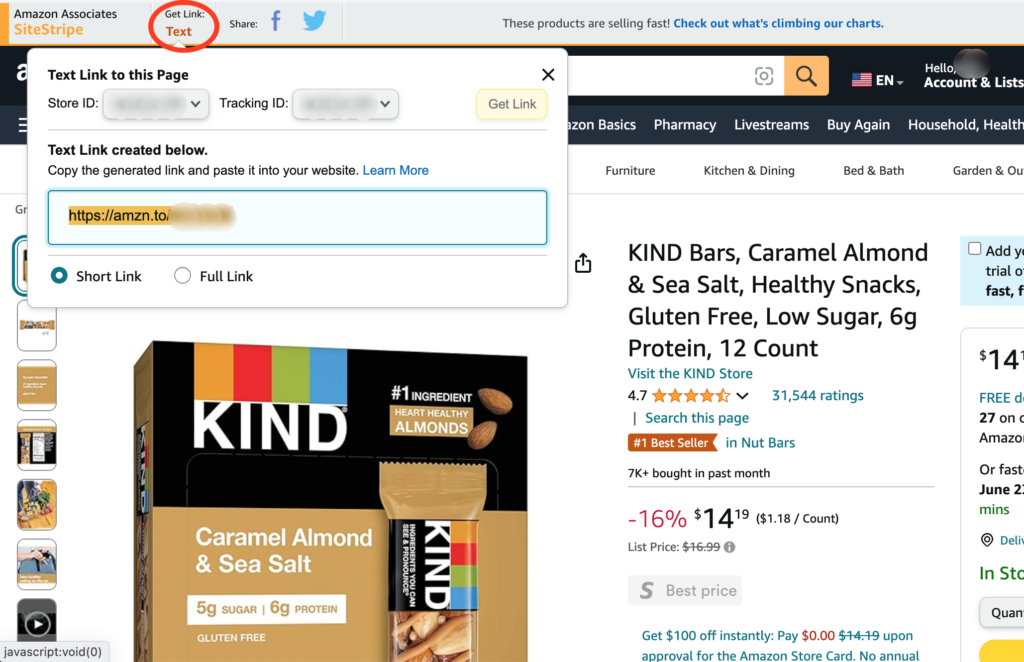
You can generate either a short link or a full link and copy it to share it wherever you like (such as your social media app of choice)!
The great part is, you just need to embed the code given to you, and all the correct product data (and formatting you selected) will be pulled from Amazon right to your site.
(Note that Amazon previously allowed you to create a link using one of three options: Text, Image, or Text+Image. In 2024, they phased out Image and Text+Image, leaving Text as the only option.)
How to create your first affiliate link using mobile GetLink
To create an affiliate link using Mobile GetLink:
1. Open the Amazon app on your mobile device, and log in using your Associate credentials.
2. Search for the product you want to create a link for, and click the Share icon near the top right.
3. Select your Associate ID and a tracking ID* if necessary, then click Copy Associates Link.
4. You can now paste the product link to share it.
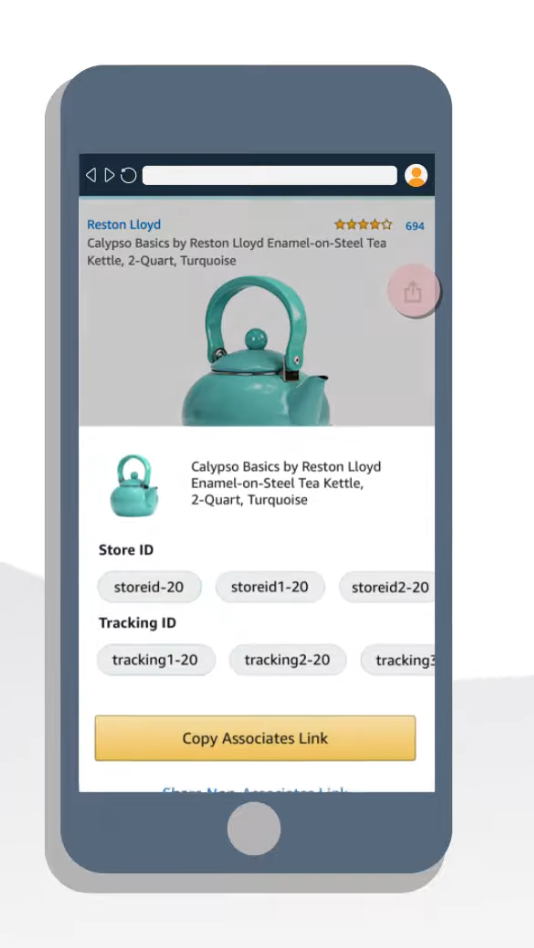
*Tracking IDs are useful for analyzing the performance of different sharing sources or strategies under the same Associates account. For instance, if you wanted to share your affiliate link for a given product on Instagram and Twitter to see which one performed better, you would create separate tracking IDs for each platform.
Happy affiliate linking!
Learn to choose the right affiliate products and services
Your affiliate marketing success depends on choosing the right product mix for your audience. The Affiliate Marketing Cheat Sheet will teach you how to find the products best aligned with the needs of your audience.

8 tips for generating Amazon Affiliate income
Now that we’ve covered the basics—why you might choose the Amazon affiliate marketing program, and how to get started—let’s dig in to specific ways you can increase your chances of success as an Amazon Associate.
As we talked about earlier, one of Amazon’s biggest advantages as an affiliate network is the trust factor. People know and trust Amazon, so you shouldn’t have to spend too much time convincing them that the site is worth buying from.
But that doesn’t mean you can just sit back and watch the affiliate sales roll in.
There are several tips and tactics you can use to improve your affiliate marketing on Amazon, to increase your conversion rates and income and create a better experience for your audience when they purchase products through your Amazon affiliate program links.In this section, we’ll talk through some of the things you should do as an Amazon Associate, along with several things you should definitely avoid doing if you want to succeed.
Must do #1: Get to know the Amazon affiliate product you’re promoting
This tip is a must for any affiliate product or service you’re promoting. Ideally, it’s something you’ve used yourself, have benefited from, and know inside and out.
I talk about this a lot, and it comes back to trust. What makes people want to buy from you, or purchase a product you’re promoting as an affiliate? It’s not a slick sales pitch. That may work for a little while, but what will get you lasting results is building a relationship with your audience based on trust.
And only promoting products you know and have used and benefited from is a great way to establish trust, because it shows your audience that you’re not going to try to sell them on something you don’t already trust yourself.
It’s like that old commercial where the guy says, “I’m not just the president of Hair Club for Men. I’m also a member.” (Okay, I’m probably dating myself here, but hopefully you get the point!)
This point is especially important when it comes to affiliate marketing on Amazon. Why? One of the things about Amazon Associates affiliate marketing you need to watch for is that once you’re up and running as an affiliate, the barrier to entry to promote a new product is pretty low.
Because Amazon has a huge selection, and it’s so easy to generate an affiliate link for just about any product, it can be easy to fall into the trap of promoting an Amazon affiliate product without getting to know the product first. As a result, it can be really easy to start promoting something you don’t know very well, and risking the trust of your audience in the process.
Must do #2: Show people what they’re going to get—unbox the mystery
This next one is not exclusive to Amazon, but it’s probably going to give you the biggest bang for your buck with Amazon. That is, showing people what they’re going to get before they get it. Instead of just talking about the product or sharing a little information about it, then posting your affiliate link and leaving it at that, you can give people a much richer preview of their potential experience with a given product.
A great way to do this is to go into deep detail about what the product is and how it works, by shooting a video.
The unboxing videos I’ve created for products I promote, both physical and digital, have worked really well for me in terms of driving purchases and affiliate income.
Videos are a great way to show the ease of use of a particular product, and give your audience a chance to imagine themselves using it.
I’ve created unboxing videos for a number of Amazon products in particular, like the one where I unboxed three different podcasting microphones under $75:
Videos also make it easier to build a relationship with your audience; you can talk right to them, and they can hear your voice (and see your face, though that’s not always necessary). Plus, not only are you sharing what the product looks like and how it works, since you’re the one who’s showing your audience how it works, you’re also building your authority with them as an expert they can trust.
And the best part? No pitch is even required! Just show people how the product works, be honest and thorough, and the power of video will do the rest.
Must do #3: Be honest
Here’s another tip that doesn’t just apply to Amazon affiliate program links, but is crucial to remember if you want to be successful promoting Amazon products: be honest. This may sound like one of those “d’uh!” tips, but trust me when I say that it can still trip people up.
The first place where honesty is crucial in affiliate marketing with Amazon Associates is in how you represent the product itself. This may go without saying, but if you oversell or flat-out lie about what a product can do for someone, it’s going to backfire, big time. And not just in terms of your affiliate sales for that product, but in the likelihood people will continue to trust you at all. You can always find new affiliate products to promote, but once you’ve lost your audience’s trust, it’s hard if not impossible to gain it back. This is why using a product yourself and getting to know it inside and out is extra important, because the chances you’ll misrepresent the thing you’re promoting are much, much lower when you’re an expert on it.
The second place where honesty is crucial is in how you represent your affiliate links themselves. I always recommend being honest with the fact that you can earn a commission when people use your affiliate links to purchase a product. In fact, the FTC requires that you disclose when you’re using affiliate links, but beyond even that, it’s just good practice to let people know that you’ll make money when they purchase via a link on your site.
This can be as simple as adding a single disclaimer at the top of a blog post in which you’re sharing affiliate links. I’ve had people tell me it feels odd to tell visitors that you’re making money from an action they’re taking, and I get it, but the truth is this: it doesn’t cost those visitors anything to use your link (beyond the cost of the product), and once you help them, they’ll often look for ways to help you in return. And providing affiliate links is an easy way to let them do that, at no extra cost to them!
Must do #4: Offer people support for Amazon products they purchase through your links
Finally, when promoting a product with the Amazon affiliate program, offer to help your audience with the product. Be a source of support. If people have questions or people want to know more about the thing you’re promoting, make their decision easier and offer them that support! But, you might think, am I going to have people beating down my door asking for help with the product? I’m too busy for that! Here’s the thing. Very few people will actually take you up on that offer. But a lot more people will see your offer of assistance and appreciate it. They’ll see you as an authority figure, and someone they can trust to help them out if they need it, someone who stands behind the products they promote, even if those products aren’t your own.
Plus, if somebody does come to you with a question about the product you’re promoting, that means they’re probably interested in buying it, and by being there in a support role, you can help move them closer to a purchase decision. That’s a win for them, and a win for you.
Must do #5: Use Geniuslink to optimize your Amazon affiliate program links internationally
Earlier in this article, I showed you how to sign up for an Amazon Associates account on Amazon.com, which is the company’s US-based site. But this is not Amazon’s only affiliate site.
In fact, it has affiliate programs in 18 other countries, including Canada, Mexico, Brazil, the UK, Germany, France, Italy, the Netherlands, Poland, Spain, Sweden, United Arab Emirates, Saudi Arabia, China, India, Japan, Singapore, and Australia. And in order to earn affiliate income from those sites, you need to set up an account on each of them—your US affiliate account doesn’t automatically “cover” you on the international sites.
That’s right: if you promote an affiliate link for a podcasting microphone on Amazon.com, you won’t get paid if someone in England clicks on your link but buys the microphone from Amazon.co.uk.
So what can you do? Create an account on the US site plus all 18 of the different international Amazon sites, and create 19 separate affiliate links for each product you want to promote . . . then add all 19 links to each mention of that product in your blog post? Phew! That sounds exhausting, and unlikely to be effective either.
That’s where Geniuslink comes in. This tool lets you do two powerful things that can make your international Amazon affiliate marketing program much simpler and more effective.
First, Geniuslink lets you identify where a website visitor is in the world based on their browser’s geolocation, then send them to a specific page based on that location.
Second, it allows you to create a universal link for each of your Amazon affiliate products that uses a visitor’s geolocation to determine which international Amazon store to send them to.
Translation: Geniuslink lets you use one link (not 19!) for each Amazon affiliate product you’re promoting in your content. Then it does the work on the back end to send the person who clicks on your link to the right Amazon site for their location in the world.
This is super useful, and will help you make more money as an Amazon Associate by tapping into customers around the world.
Must do #6: Take advantage of the holiday season
This next one is a short one, but it’s a big one. As you probably know (and have experienced!), the holiday season is a huge shopping period—which means it’s also potentially a great time for affiliate sales. The lead-up to the holiday shopping period is an important time to promote your affiliate links, so you might want to think about doubling down on your promotional efforts in the fall.
At the same time, you’ll want to be careful not to overpromote your affiliate products this time of year—people are expecting a lot of marketing, but you still want to be careful not to oversaturate your audience.
Plus, it can be especially tempting this time of year to “catch the wave” of holiday shopping excitement and—as we talked about earlier—start promoting products you don’t know well and haven’t even used personally. While that may lead to some extra sales in the short term, in the long run you risk your audience’s trust by promoting products you don’t know and can’t stand behind.
So take advantage of the holiday shopping period, but don’t get carried away!
Must do #7: Read the Amazon Associates fine print
Okay, so far we’ve talked about some of the key strategies for success as an Amazon affiliate, focused mostly on the positives—the what to dos—along with a few things to avoid. Now let’s talk about a few more things on the negative side of the equation: the practices you need to avoid if you want to grow your affiliate income (and yes, avoid getting in trouble with Amazon).
Amazon is known for sometimes coming down hard on sellers, affiliates, and other partners who don’t follow the rules. This is maybe the other big downside of being an Amazon affiliate program member—Amazon is big enough to boss you around if you step out of line, and there’s usually not much you can do about it. I’ve heard stories of affiliates having their accounts closed without any chance for recourse or appeal when they went against one of Amazon’s affiliate policies.
Usually, Amazon will give you a warning if you’re not following one of their policies, but in any case, it’s always better to be safe than sorry!
A big part of this is reading and understanding the fine print in Amazon’s affiliate policies. Like I mentioned earlier, spending the time to read through them will be worth it. The last thing you want is to be blindsided by a suspension for ignoring one of Amazon’s policies without even knowing it.
In the rest of this section, I’m going to focus on several excerpts from those policies that you should be especially aware of. I’ll share the exact language from Amazon’s policy documents, followed by my own comments.
The first policy has to do with what kind of website you use to promote your affiliate links (and yes, you need to have a website if you want to be an affiliate marketer!). Amazon has a list of what it calls “unsuitable sites” that they won’t allow into the Associates program.
Amazon’s language: “Unsuitable Sites include those that:
- promote or contain sexually explicit or obscene materials,
- promote violence or contain violent materials or promote, endorse or incite potentially dangerous or harmful acts,
- promote or contain false, deceptive, libelous or defamatory materials;
- promote or contain materials or activity that is hateful, harassing, harmful, invasive of another’s privacy, abusive, or discriminatory (including on the basis of race, color, sex, religion, nationality, disability, sexual orientation, or age);
- promote or undertake illegal activities;
- are directed toward children or knowingly collect, use, or disclose personal information from children under 13 years of age or other applicable age threshold (as defined by applicable laws, regulations, and/or guidelines); or violate any applicable laws, ordinances, rules, regulations, orders, licenses, permits, guidelines, codes of practice, industry standards, self-regulatory rules, judgments, decisions, or other requirements of any applicable governmental authority related to child protection (for example, if applicable, the Children’s Online Privacy Protection Act (15 U.S.C. §§ 6501-6506) or any regulations promulgated thereunder or the Children’s Online Protection Act);
- include any trademark of Amazon or its affiliates, or a variant or misspelling of a trademark of Amazon or its affiliates in any domain name, subdomain name, in any “tag” or Associates ID, or in any username, group name, or other identifier on any social networking site (see a non-exhaustive list of our trademarks listed on our Non-Exhaustive Trademark Table)); or
- otherwise violate any intellectual property rights.”
Translation: Amazon won’t let you join their affiliate program if your site is involved in anything illegal, deceptive, violent, or hateful. But even if this doesn’t describe your site (and I really hope it doesn’t!), keep in mind that sites of an “adult” nature may not be allowed either. Also, even if your site is totally family friendly, if it’s focused on kids it still may not be allowed, as Amazon says it won’t accept sites directed toward kids who aren’t teenagers yet.
Next, Amazon’s policy on where you can use your affiliate links (what Amazon calls “Special Links”) and where you can’t.
Amazon’s language: “You will not engage in any Promotional Activities in any offline manner, including by using any of our or our affiliates’ trademarks or logos (including any Amazon Mark), any Program Content, or any Special Link in connection with any printed material, ebook, mailing, or any oral solicitation. You may include Special Links in emails, SMS and direct messaging from your social media Sites; provided, that such communications are solicited (i.e., opted into by the receiving customer) and are otherwise in compliance with the Agreement, the Trademark Guidelines, and the Amazon Brand Usage Guidelines.”
Translation: Don’t put your affiliate links anywhere except on your website, blog posts, online videos, emails, SMSes, or direct messages. Period. That means no links in lead magnet PDFs, printed flyers, ebooks… if it’s not a blog post, web page, email, SMS, or direct message, don’t use your affiliate link there.
(It’s important to note that Amazon recently relaxed this policy a little bit—previously, you weren’t allowed to put your Special Link in emails, SMSes, or direct messages.)
In fact, if you try to add an Amazon Associates link to a Kindle ebook, you’ll get a message like this:
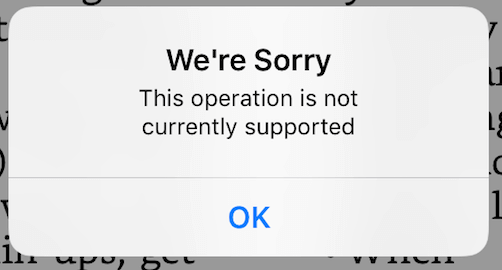
Which is actually pretty helpful, if you think about it. But you won’t get a friendly warning like this if you try to use your affiliate link in an email, so just remember: blog post or web page only.
The next policy covers the importance of being honest about the Amazon affiliate program products you’re promoting using your affiliate links.
Amazon’s language: “You must not make inaccurate, overbroad, deceptive or otherwise misleading claims about any Product, an Amazon Site, or any of our policies, promotions, or prices.”
Translation: Don’t lie about the Amazon affiliate products you’re promoting. This seems pretty obvious, but this also means not overpromising or misrepresenting the products you’re promoting, even in a small way. (For instance, don’t say the camera you’re promoting has 20 megapixels when it really only has 15.) Now, of course innocent mistakes and typos can still happen to anyone, so double-check everything you write about the products you’re promoting to make sure it’s accurate.
Finally, something you shouldn’t encourage your audience to do with your affiliate links.
Amazon’s language: “You must not encourage customers to bookmark your Special Links.”
Translation: This one’s pretty self-explanatory. Don’t ask people to bookmark your affiliate link for later use.Those are a few of Amazon’s affiliate marketing policies I want you to be aware of as you’re getting started, but that’s definitely not all of them. That’s why I still recommend you review all of the policies for yourself too.
Must do #8: Don’t put all your eggs in the Amazon Affiliate Program basket
Last but not least, don’t make Amazon Associates your only affiliate marketing option. I’m a huge proponent of diversifying your income sources, and doing so has been a big reason for my own success.
Part of the reason I recommend diversifying is because, as we talked about earlier, Amazon affiliate commission rates tend to be lower than they are from other affiliate income sources. I’ve seen this in my own affiliate marketing, where my commission rates and overall income from Amazon are not as high as they are for many of the products and services I promote on other platforms and from other companies.
Amazon Associates is not my biggest source of affiliate income. But for some of you out there, it might be (or might someday). It’s just as important for you to diversify—maybe even more important—for the simple reason that relying too heavily on one source of income could leave you in a tough spot if that income source were to dry up for any reason.
I’ve seen too many folks in the online business space “bet it all” on one source of income, and when that income source didn’t pan out the way they wanted to, they didn’t have a backup plan in place to weather the storm.
If you become wildly successful as an Amazon affiliate program member, hopefully using the tips I’ve shared in this article, then great! But I still recommend you not put all your affiliate eggs in the Amazon Associates basket—or any single basket.
6 Bonus Tips for Boosting Your Amazon Affiliate Income
Let’s say you’ve gotten started promoting your new Amazon affiliate links, and you’re seeing some success. (Nice work!) But you want to take things to the next level. Or maybe your affiliate income hasn’t really taken off, and you need some help jump-starting things.
Here are six strategies to inject a little life into your Amazon affiliate marketing efforts.
Tip 1: Blog
Make more affiliate sales by upping your blogging game. The key is to publish quality content targeting relevant keywords—while incorporating your affiliate links in a natural way—so you can inform and entertain your audience and make some affiliate sales while you’re at it. Make sure all of your content addresses your audience’s needs (SEO-optimized, of course!).
Tip 2: Write product reviews/comparison posts
Product reviews and comparison posts are a subset of blogging, but they’re worth their own entry. Focus on creating detailed, well-informed, honest reviews and comparisons, with high-quality images, and layered with your personal experiences where possible. By helping readers make informed purchase decisions, you can build trust and increase purchases through your links.
Tip 3: Create an Amazon storefront
An Amazon Storefront is a page on Amazon’s site that allows you to showcase your favorite products and themed collections. It’s a particularly great way to highlight seasonal items or deals. Plus, you get access to Amazon’s analytics to help you refine your strategy and grow your affiliate sales even further.
Tip 4: Join the Amazon Influencer Program
The Influencer Program is an “extension” to the Associates program, specially for social media influencers, that lets you create a customizable Amazon page to showcase recommendations through shoppable content. Unlike a regular Amazon Storefront, you can also post photos and videos about products and participate in Amazon Live events to drive real-time sales.
Tip 5: Share promo codes
As an affiliate, you can share promo codes with your audience. They provide a great way to promote Amazon promotions and deals, especially during major shopping events. Even better—create content explaining the best deals, including your affiliate links. You can find active promo codes by logging in to your Associates account and going to Promotions -> Amazon Promo Codes.
Tip 6: Take advantage of Amazon’s Creator Connections Program
Creator Connections connects sellers (that’s you!) with influencers to help you discover new products aligned with your niche. By creating content showcasing these products and forming partnerships with influencers, you can make product recommendations that better resonate with your audience and hopefully grow your sales.
As always, make sure to incorporate affiliate links naturally into your content, and always disclose your affiliate status!
Amazon Affiliate Program Frequently Asked Questions (FAQs)
Here are some of the most commonly asked questions about the Amazon Associates program.
- How does the Amazon Associates program work?
- You promote Amazon products on your website or platform using unique affiliate links. When someone clicks your link and makes a purchase, you earn a commission.
- How much can I earn as an Amazon affiliate?
- Earnings vary widely, but commissions typically range from 1% to 10% of the product price, depending on the category.
- What are the requirements to join the program?
- You need a website, blog, app, or YouTube channel with original content and a decent amount of traffic. Amazon reviews applications to ensure quality.
- What types of products can I promote?
- You can promote almost any product available on Amazon, with a few exceptions like adult products or certain restricted categories.
- How long do cookies last for affiliate purchases?
- Amazon’s affiliate cookies last for 24 hours. If a customer adds an item to their cart, the cookie extends to 90 days.
- When and how do I get paid?
- Payments are made monthly, typically 60 days after the end of the month in which you earned the commission. Payment methods include direct deposit, check, or Amazon gift card.
- Are there any restrictions on how to use affiliate links?
- Yes. For example, you can’t use affiliate links in offline promotional materials, email, or eBooks.
- How do I track my earnings and performance?
- The Amazon Associates dashboard provides detailed reports on clicks, sales, and earnings, allowing you to track your performance over time.
- Can I participate in the program if I’m not based in the US?
- Yes, Amazon has affiliate programs in many countries, but you’ll need to apply to the specific program for your country.
- How does Amazon prevent fraudulent activity in the program?
- Amazon uses sophisticated tracking systems and manually reviews accounts to detect and prevent fraudulent activities like self-clicking or incentivized purchases.
- What happens if I violate the program’s terms of service?
- Violations can result in account suspension or termination, and Amazon may withhold earnings if they suspect fraudulent activity.
Success with the Amazon Affiliate Program Is About Trust
Amazon is the most popular marketplace in North America, and it’s growing worldwide too. It’s the single biggest place where US shoppers start their product searches, so it’s definitely a smart option to add to your affiliate marketing repertoire.
To be successful as an Amazon affiliate marketing program member, you need to understand a few important best practices specific to Amazon Associates, including how to maximize your affiliate income potential across Amazon’s international sites, and how to promote your affiliate links correctly so you don’t go against Amazon’s strict policies.
But beyond these specific points, promoting Amazon affiliate program products really involves the same ground rules that apply to affiliate marketing in any form or on any other site or network. That is, know the products you’re promoting, be honest in how you represent those products, and give people enough information to make an informed decision about the product.
Here’s what it comes down to. Successful affiliate marketing on Amazon is built on the same foundational principle that all affiliate marketing—and all online marketing and business—is based: trust. In the end, Amazon Associates is another tool that helps you help your audience and build their trust further, by promoting products that will help them achieve their goals.If you want to dive deeper, check out my how to get started with affiliate marketing ultimate guide here!